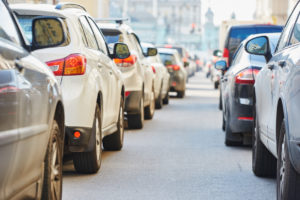 ‘Tis the season…for heavy traffic.
‘Tis the season…for heavy traffic.
Heavy traffic sets up one of the most dangerous circumstances I see in my personal injury practice.
Approached with alert, common sense, they aren’t dangerous at all. Unfortunately, “alert, common sense” seems less common than “inattentive autopilot”.
The result? Crash after crash after 100% preventable crash.
Heavy traffic gets backed up. Traffic that would otherwise be flowing is slowed down and comes to a stop.
What do you do at an intersection in bumper to bumper, stop and go traffic? You stop, even though you are facing a green light, so you don’t end up stuck in the middle of the intersection blocking traffic.
An oncoming, left turning driver catches your eye. You wave your hand, confirming that you see her, and she proceeds in front of you to complete her turn.
If it wasn’t for your courteous driving, and that of the driver in the lane next to you, that left turner would have to needlessly sit there until the light changes. She would then be blocked by your stopped vehicle, and have to wait even longer.
This scenario plays itself out countless times, every day on British Columbia roads, without any problem.
From time to time, though, the “perfect storm” of crash circumstances will arise when a vehicle in the HOV lane happens to be sailing through at exactly that moment, the two vehicles violently crashing into each other.
Neither the left turner, nor the HOV driver, can see the crash coming. The two lanes of stopped traffic are blocking their view of each other.
Is it an unpreventable crash? Hell, no.
Who has the right of way? Clearly, according to the Motor Vehicle Act, it’s the straight through driver. A left turner must yield to oncoming vehicles.
The judge in the recent case of Purewal v. Li, 2016 BCSC 1792, a September 29, 2016, decision, applied the rules of the road and found the left turner 100% at fault. The left turner in that case had been “waved through” by one of the stopped, straight through, drivers, and failed to even look for vehicles that might have been sailing along in the curb lane.
But the “rules of the road” are not the “be all and end all” when considering liability.
The exact opposite conclusion was drawn by a judge in a January 10, 1990, decision. In Johanson v. Mann and Loften, an unreported decision, the judge found the straight through driver 100% at fault: “His fault was that he was careless in entering the congested intersection at considerable speed past the stopped traffic on his left without anticipating that the plaintiff might emerge…The passing a line of stopped cars on the left through an intersection is probably the most risky thing a driver can do. He would have no chance to avoid whatever emerged in the left be it a pedestrian or a car.”
The left turner in that case had been proceeding very slowly and cautiously, acutely aware of the possibility of a vehicle in the curb lane. The judge noted that she had to inch the front of her vehicle into the curb lane in order to be able to look for oncoming traffic.
In each case, and there are many of these cases, the level of care of each driver is considered in the context of the rules of the road and a fair assessment is made by the judge. Often, liability is shared between the two drivers, neither of them showing the level of attentiveness and care that is required.
If each of the left turner and HOV driver simply slowed down, aware that at exactly the worst moment the other could appear in front of them, this horribly common, and horribly destructive, crash would never, ever occur.
What does the lack of attentiveness and care cost British Columbians. In one of the cases, the injuries and financial losses of only one of the drivers were assessed at close to $500,000.00. Add associated medical care, emergency services, vehicle damage, and the losses of the other driver and the dollars and cents really add up.
Inject just a little more common sense and attentiveness into our driving and ICBC premiums, and taxes, might go down instead of up. That, and fewer people would suffer life-long injuries and fewer would die.
In this season of heavy traffic, please let’s each of us do our part to avoid this and all other completely preventable crashes.

0 Comments